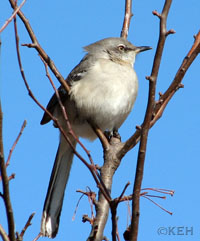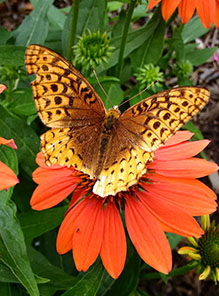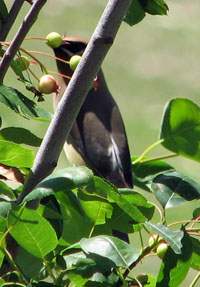
Country Birder... and Butterflies

 |
Country Birder... and Butterflies |
 |
| Cedar Waxwing |
| Previous | View Butterflies | Return to Home | Next |
 |
Cedar Waxwings are frugivores,
meaning they feed primarily on fruit. According to online
resources, Cedar Waxwings will also feed on insects, but appear to time
their nesting and breeding with the availability of fruit sources.
May 14 was the first time I observed a Cedar Waxwing in the yard, and it
was eating the white flower blooms of a Washington Hawthorn tree.
The bird in this picture is sitting on the branch of a Black Gum tree. Central Indiana - June 11, 2008 |
 |
Cedar Waxwing, sitting among branches of
Serviceberry tree. The berries are just beginning to ripen, and I
counted two Cedar Waxwings picking off the red berries. Per online
field guides, Cedar Waxwings tend to move around in their range, often
in flocks, sometimes settling only long enough to strip ripe fruits from
their sources before moving on. Central Indiana - June 11, 2008 |
 |
Having a Cedar Waxwing stop to dine at our yard
is a high point for me this season. Three years ago, the property
(literally in the middle of a corn field) had no fruit-bearing trees or
shrubs for wildlife. Every tree and shrub I planted has been with
the intent of providing some wildlife value, and of course with the
selfish intent of attracting songbirds to the yard. I planted three Serviceberry shrubs, twenty Silky Dogwood, and about ten "Blue Muffin" Arrowwood Viburnum. This is the first year that the Serviceberries have produced fruit, and the Dogwood and Viburnum show great promise for later in the season. Central Indiana - June 11, 2008 |
 |
Cedar Waxwings enjoying the fruits of the
Serviceberry tree. Central Indiana - June 13, 2008 |
 |
I finally captured a picture showing the detail
of the red waxy pigment, for which the Waxwing gets its name, on the
tips of the secondary feathers. The tail tip on this bird
appears orange, while we usually expect the tip to be yellow. It
could be a trick of the light (this photo was taken under less than
ideal circumstances), but according to the Cornell Lab of Ornithology
online bird guide, consuming berries of an introduced species of
Honeysuckle causes the tail to develop an orange tip if consumed during
feather development. Central Indiana - June 17, 2008 |
Click the link below for descriptive material provided by eNature.com
| Cedar Waxwing | Return to Home |